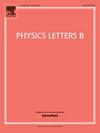引力波探测的测量诱导纠缠熵
IF 4.5
2区 物理与天体物理
Q1 ASTRONOMY & ASTROPHYSICS
引用次数: 0
摘要
对引力子的射影测量的研究越来越支持戴森关于探测单个引力子的物理限制的观察。因此,谨慎地考虑引力波探测中非经典性的替代特征,以确定重力是否被量子化。同时的多个探测器操作使得在检测过程中考虑二部测量引起的纠缠成为可能,作为非经典性的标志。通过建立一个基于二部系统中固定数量的引力子的测量诱导纠缠模型,我们证明了纠缠熵是与探测器相互作用的引力子平均数量的几个百分点。测量诱导的双部纠缠是探测过程的一部分,它避免了由于引力波探测器效率极低而导致的与开发生产诱导纠缠特征相关的挑战。归一化测量引起的纠缠熵的计算表明,基于引力辐射的二部探测,有可能发展出有物理意义的非经典特征。这一结果与基于单点探测的令人沮丧的计算结果形成鲜明对比。本文章由计算机程序翻译,如有差异,请以英文原文为准。
Measurement-induced entanglement entropy of gravitational wave detections
Research on the projective measurement of gravitons increasingly supports Dyson's observations on the physical limitations of detecting single gravitons. It is therefore prudent to consider alternative signatures of non-classicality in gravitational wave detections to determine if gravity is quantized. Coincident multiple detector operations make it possible to consider the bipartite measurement-induced entanglement, in the detection process, as a signature of non-classicality. By developing a model of measurement-induced entanglement, based on a fixed number of gravitons for the bipartite system, we demonstrate that the entanglement entropy is on the order of a few percent of the mean number of gravitons interacting with the detectors. The bipartite measurement-induced entanglement is part of the detection process, which avoids the challenges associated with developing signatures of production-induced entanglement, due to the extremely low gravitational wave detector efficiencies. The calculation of normalized measurement-induced entanglement entropy demonstrates the potential of developing physically meaningful signatures of non-classicality based on bipartite detections of gravitational radiation. This result is in stark contrast to the discouraging calculations based on single-point detections.
求助全文
通过发布文献求助,成功后即可免费获取论文全文。
去求助
来源期刊

Physics Letters B
物理-物理:综合
CiteScore
9.10
自引率
6.80%
发文量
647
审稿时长
3 months
期刊介绍:
Physics Letters B ensures the rapid publication of important new results in particle physics, nuclear physics and cosmology. Specialized editors are responsible for contributions in experimental nuclear physics, theoretical nuclear physics, experimental high-energy physics, theoretical high-energy physics, and astrophysics.
 求助内容:
求助内容: 应助结果提醒方式:
应助结果提醒方式:


